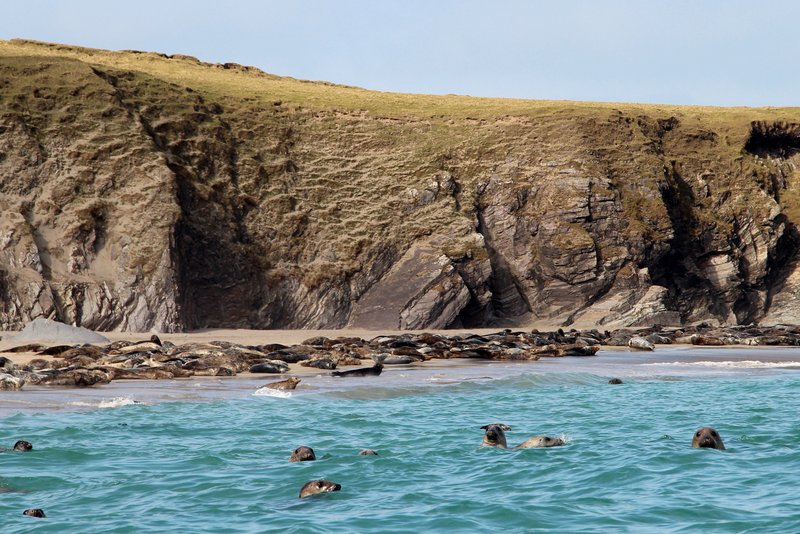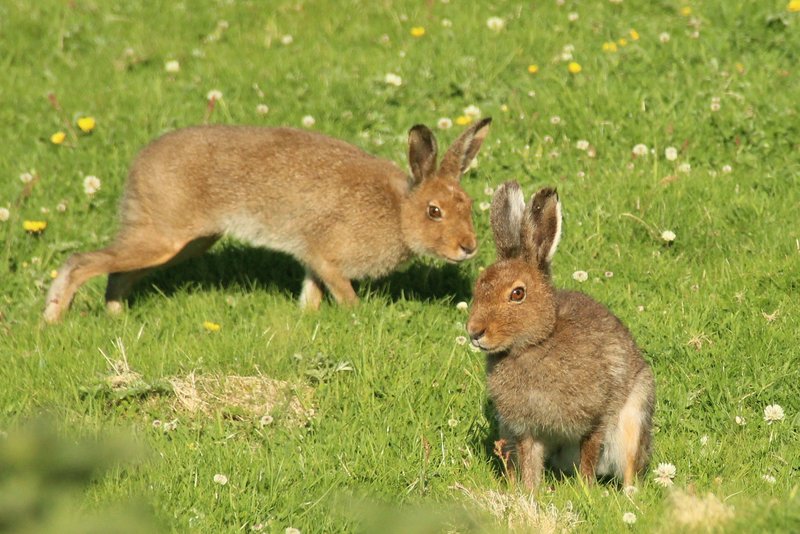Great Blasket Island part of European designated S.A.C. & S.P.A.
Grey seals on Great Blasket Island


![]() For Tour Information and Options click here
For Tour Information and Options click here
Video
Hares on Great Blasket Island

Blasket islands S.A.C. and S.P.A. No Management Plans....no resident / permanent Wildlife Rangers....... no baseline bird population(s) survey or monitoring......
The Blasket Islands archipelago is the jewel in the crown of marine nature reserves in County Kerry, Ireland and Europe and has rightly been designated with European Protected Status (supposedly) as both SAC [ Special Area of Conservation] and SPA [ Special Protection Area] with special reference to the European Habitats Directive and the European Birds Directive collectively called the Natura 2000 network.
But there is no protection for the wildlife on these islands, especially the birds, and no Management Plans or permanent NPWS Wildlife Rangers as would be the norm in other countries (even so called third world countries), with trained Rangers given special designation and responsibility for the marine, terrestrial and fragile avian wildlife populations on the islands. This reflects the current Irish State's obsession with trying to increase tourist numbers to ever increasingly resourced "Heritage Centres" and staffing of Heritage Sites with up to seven OPW staff for Great Blasket island proposed for 2018 season, a similar number for Skellig Michael and zero NPWS staff and zero funding towards protecting the fragile habitats, ecosystems and wildlife of the islands.............
https://www.facebook.com/rtetoday/videos/1915310855147428/
Grey seals (Halichoerus grypus) and Harbour porpoises (Phocoena phocoena) thriving in Blasket Islands S.A.C. (no. IE0002172)
Grey seals and Harbour porpoises are both thriving in the Blasket Islands SAC with in excess of 1,500 grey seals recently hauled out for the moult period on the Trá Bán (White Strand) on the Great Blasket Island. Harbour porpoises also appear to be thriving although their actual population density (500 +) can only be judged on fine calm days with sea state 1 or 2 when they always appear more plentiful than on choppy days when they can be very difficult to spot.
But in recent years the habitat on the Great Blasket Island and Beginish is very degraded with the signature "impoverished maritime flora" on the Great Blasket Island swamped by an ever increasing deep carpet of silverweed ( Argentina anserina) in some places 1 meter thick, swamping all the Sweet Scented Vernal grass; Brown, Creeping and Common Bent grass; Early and Silver Hair-grass; Wild-oat grass; Yorkshire Fog; Fern grass; Cock's Foot grass and the Squirrel-tail, Sheep and Red Fescue and other ecologically diverse, miniature and impoverished maritime flora that have made the Great Blasket island a special place for botanists and naturalists for generations including Filmy Fern; Wood Violet; Field Mouse-ear; St. Patrick's Cabbage; Eyebright (special Blasket variety); Hairy Bittercress; Corncockle; Lesser Stitchwort; diminutive Birds-foot Trefoil and rare Early-purple Orchid. Like the karst landscape of the Burren in Co. Clare at first glance it appeared that there was nothing much of interest there until you got down on your knees and saw how all the flora had miniaturised to adapt to the (former) close grazing by sheep and the harshness of Atlantic sea spray and gales.
This pleasure is no longer possible with the present inadequate grazing regime on the island.
Not so many years ago when the author of this log lived and fished from the Great Blasket Island you could walk all over the island in bare feet and pick field mushrooms from beside the wandering sheep tracks as the grass was trimmed back like a wildflower-studded lawn by the adequately stocked 1,000 plus head of sheep for the nearly 1,000 acres on the island. Nowadays there is a serious Health and Safety issue as the uneven ground underfoot is not visible due to the deep carpet of silverweed and also due to poor animal husbandry and mismanagement of the sheep on the island and the under-grazing of the sward, there are now plagues of midges rising from the extensive ground cover and you need to wear boots and protective leggings to avoid picking up ticks (and associated very serious medical problems) from the long, rank, overgrown and under-grazed vegetation.
This ecological disaster in an E.U. designated SAC and SPA need never have happened if a properly designed Management Plan was put in place involving all stakeholders and if the sheep grazing regime on the island was properly managed and the island adequately stocked to avoid encroachment of ground covering invasive weedy species like silverweed suffocating the species-rich floral understory. There is an immediate requirement for a minimum of 1,000 properly managed and healthy flock of sheep to replace the poor quality mis-managed interbred specimens currently on the island and possibly a small herd of native Kerry cows or Kerry bog ponies to graze the rank grass and silverweed which was never previously allowed to flourish and spread on the Great Blasket Island which the former Blasket Islanders grazed with cattle and donkeys as well as sheep.
Blasket Islands S.P.A. (no. IE0004008)
According to the "Natura 2000 - Standard Data Form" the Blasket islands SPA was first classified in February 1986 and first compilation date by NPWS was September 2003. Yet in April 2018 there are still no Management Plans for the Blasket islands SAC or the Blasket Islands SPA. Furthermore as far as can be ascertained from the Natura 2000 - Standard Data Forms for the Blasket Islands there is no "National legal reference of S.A.C. or S.P.A. designation".!!!
Birdlife on the Blasket islands, which are a National Treasury of marine avian wildlife in Ireland, is under serious threat from totally unsuitable grazing regimes (too little on Great Blasket Island destroying the delicate ecological balance there; too much on Beginish which the former flock of nearly 200 Greenland over-wintering white-fronted geese have abandoned) and the uncontrolled introduction of American mink (Neovision vision) to Great Blasket Island which species will inevitably reach the outer islands where our puffins, Manx shearwaters, Choughs, Arctic terns and our other seabirds nest below ground, on shingle beaches, in caves and on cliff ledges and are all vulnerable to predation and total elimination by American mink.
From the NPWS own Natura 2000 - Standard Data Forms ( SAC and SPA) the population of choughs on Great Blasket island has halved from minimum 12 breeding pairs to maximum 5 breeding pairs; the population of Arctic terns on Beginish has gone from minimum 200 to minimum 1 (!) and maximum 100 (!) and populations of Herring gulls, Great Black-backed gulls and Shags have halved from 130 breeding pairs of Herring gulls to 71; from 400 pairs of Great black-backed gulls to 113 and from 350 breeding pairs of Shags to 48 (!)
The Irish State needs to invest in protecting our precious Wildlife Heritage rather than overselling and over investing in cultural and built heritage tourist money-making schemes
The Blasket islands, this Treasury of Irish avian wildlife, needs urgent attention, starting with the (humane) elimination or the transportation back to the mainland of the American mink introduced to the Great Blasket island; proper grazing of the sward and management of the sheep flock; an immediate and complete baseline survey of resident, breeding, summer and winter migratory birds; resident and / or permanent NPWS Wildlife Rangers whose only responsibility is the Blasket Islands SAC and SPA; an International Bird Observatory and Study Centre located on the Great Blasket Island with properly resourced staff and most of all a Management Plan with the focus on restoring (at this stage) and protecting the various different habitats and ecological niches and requirements of the rich and varied bird life of the islands.
Note: There are approx. 51,965 breeding pairs of Storm petrels on the Blaskets - the biggest single population of European storm petrels in the world. There are approx. 23,500 pairs of Manx shearwaters and over 5,000 pairs of puffins; over 3,000 pairs of Fulmer petrels and over 700 pairs of Kittiwakes. Let us hope that the same thing does not happen to them as the vanished 200 Greenland white-fronted geese that used to over-winter on Beginish (before degradation of their habitat) or the almost disappeared but loyal few Arctic terns still returning to Beginish from their epic and record breaking migratory journeys around the world
There is still time to save this wonderful avian wonderland with goodwill from all Stakeholders and proper Funding and Resources from the Irish State for this "European Protected" (?) SAC and SPA.
Log of whale watching tour boat M.V. "Blasket Princess" Captain Whales Galore 18.04.2018















